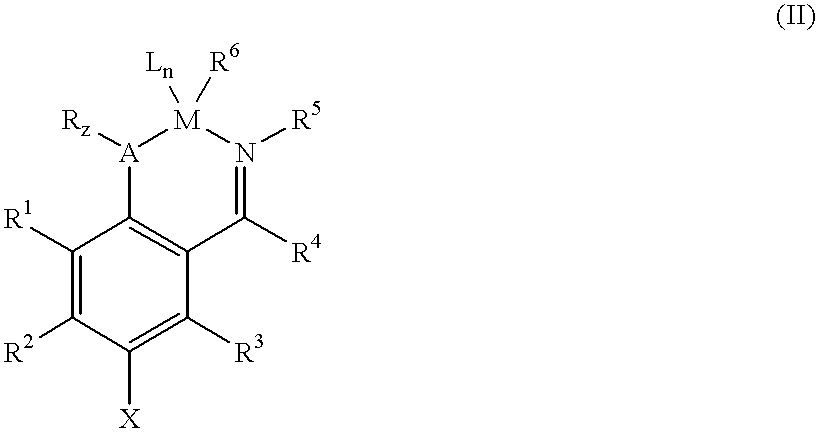Supported catalysts and olefin polymerization processes utilizing same
a technology of supported catalysts and olefin polymerization, which is applied in the direction of organic compounds/hydrides/coordination complexes, catalysts for physical/chemical processes, metal/metal-oxides/metal-hydroxide catalysts, etc., and can solve the problems of poor productivity, reactor fouling, and limited utility of catalyst compositions useful in homogenous polymerization processes
- Summary
- Abstract
- Description
- Claims
- Application Information
AI Technical Summary
Problems solved by technology
Method used
Image
Examples
example 1
Catalyst Tethered to Support Through X
Using a general procedure from Tetrahedron Lett., 36 (46), 8514-18 (1995) modified accordingly, 3-bromo-4-hydroxyphenethyl alcohol is prepared from 2,4-dibromophenol,. The alcohol moiety of the phenethyl group and the phenolic OH are then treated with methyl iodide and pyridine in THF solution and, in the process, converted to protected methoxy ether groups. A Grignard reagent of this protected compound is formed subsequently.
Magnesium turnings (1.4 equiv.) are added to a flame-dried 3-neck flask (under an Ar atmosphere) containing THF (20 mL). A small crystal of iodine is added to activate the Mg. Once the solution becomes clear, the protected alcohol / phenol (1.2 equiv.) compound from above in THF (70 mL) is added dropwise to avoid overheating. The reaction mixture is stirred for an additional 4 hours. Anthrone (1 equiv.) dissolved in THF is added to the Grignard solution at 0.degree. C. The mixture is stirred for an additional 2 hours thereaft...
example 2
Catalyst Tethered to Support Through R.sup.5
The preparation of 3-(9-anthracenyl)salicylaldehyde with a siloxy tether group is accomplished according to the following sequence of reactions.
A. 2-(anthracene)phenol-tetrahydropyran adduct
To a three-neck, 250 mL flask under an N.sub.2 atmosphere is added magnesium turnings (2.1 g, 87 mmol) in THF (20 mL). A few drops of 1,2-dibromomethane is added to activate the Mg. A solution of tetrahydropyran-protected 2-bromphenol (22 g, 87 mmol) in THF (70 mL) is added dropwise, and the reaction is stirred at reflux overnight. After this time, the resulting slurry is added by cannula to a solution of 9-bromoanthracene (22 g, 88 mmol) and NiCl.sub.2 (dppe) (1.4 g, 2.6 mmol) in THF (175 mL). The resulting solution is heated at reflux for 4 days.
Solvent is removed under vacuum, and the oily residue is separated by chromatograph on a silica gel column with 90:10 hexane / ethyl acetate. Removal of solvent yields 10 g (34%) of a white crystalline solid. .s...
example 3
Catalyst Tethered to Support Through R.sup.1
The tether moiety precursor, 9-(.beta.-hydroxyethyl)-10-bromoanthracene is prepared according to the procedure of Olah et al., J. Org. Chem. 1984, 49 2925-2937. The yield of 9-(.beta.-hydroxyethyl)-10-bromoanthracene is about 85%. The melting point is 180-182.degree. C. (decomposes). .sup.13 C NMR (CDCl.sub.3): .delta. 23.0, 61.2, 122.9, 123.1, 124.9, 125.0, 125.3, 124.7, 126.1, 126.4, 127.0, 128.9, 131.0, 134.5.
The alcohol functionality of 9-(.beta.-hydroxyethyl)-10-bromoanthracene is protected in the form of a tetrahydropyran (THP) adduct. To a dry 3-neck, 250 mL flask under an N.sub.2 atmosphere are added Mg shavings (2.1 g, 87 mmol) and dry THF (20 mL). A few drops of 1,2-dibromoethane is added to activate the Mg. A solution of tetrahydropyran-protected 2-bromophenol (22 g, 87 mmol) in dry THF is added dropwise, and the reaction is allowed to stir overnight at reflux. After this time, the resulting slurry is added by cannula to a solut...
PUM
| Property | Measurement | Unit |
|---|---|---|
| Olefinic | aaaaa | aaaaa |
Abstract
Description
Claims
Application Information
 Login to View More
Login to View More - R&D
- Intellectual Property
- Life Sciences
- Materials
- Tech Scout
- Unparalleled Data Quality
- Higher Quality Content
- 60% Fewer Hallucinations
Browse by: Latest US Patents, China's latest patents, Technical Efficacy Thesaurus, Application Domain, Technology Topic, Popular Technical Reports.
© 2025 PatSnap. All rights reserved.Legal|Privacy policy|Modern Slavery Act Transparency Statement|Sitemap|About US| Contact US: help@patsnap.com



